Author:
Max Planck Institute for Chemical Physics of Solids
Date
06/10/2020

Micro-scale device manufactured of polycrystalline TaGeIr: (a) scanning electron microscopy of synthesized specimen with single-phase regions of TaGeIr (orange rectangles), (b) micro-scale device for resistivity measurement, and (c) resistivity data, revealing semiconducting nature of TaGeIr.
The physical and chemical properties of intermetallic compounds are governed by the real structure of synthesized materials and are strongly influenced by the structural imperfections, e.g. strain, dislocations, and presence of admixture phases. This leads to inconsistent reports for known and extensively studied materials. Among such compounds is TaGeIr, which crystallizes with the MgAgAs type of structure. To understand the origin of conflicting reports on TaGeIr, scientists from MPI CPfS and Northwestern University investigated the deviation of the crystal structure from the ideal MgAgAs model, possibility of off-stoichiometry (presence of homogeneity range), impact of the synthesis route on the real structure, as well as metallographic features of TaGeIr.
As a result of this comprehensive study, the presence of minority phases (resulting from the phase equilibria in the ternary system and not complete homogenization even by long thermal treatment) in TaGeIr specimens were found to result in extrinsic metallic behavior, as well as in appearance of superconductivity at low temperatures. To study intrinsic properties of TaGeIr, the manufacturing of micro-scale devices was applied (Figure 1), and semiconducting behavior of TaGeIr was conclusively established.
The semiconducting properties of TaGeIr agree with electronic band structure calculations, revealing existence of the band gap only in case of MgAgAs-type structure with iridium atoms in heterocubic site (Figure 2). The latter is consistent with single crystal diffraction studies.
The research at the Max Planck Institute for Chemical Physics of Solids (MPI CPfS) in Dresden aims to discover and understand new materials with unusual properties.
In close cooperation, chemists and physicists (including chemists working on synthesis, experimentalists and theoreticians) use the most modern tools and methods to examine how the chemical composition and arrangement of atoms, as well as external forces, affect the magnetic, electronic and chemical properties of the compounds.
New quantum materials, physical phenomena and materials for energy conversion are the result of this interdisciplinary collaboration.
EurekAlert!, the online, global news service operated by AAAS, the science society: https://www.eurekalert.org/pub_releases/2020-06/mpif-aar060920.php